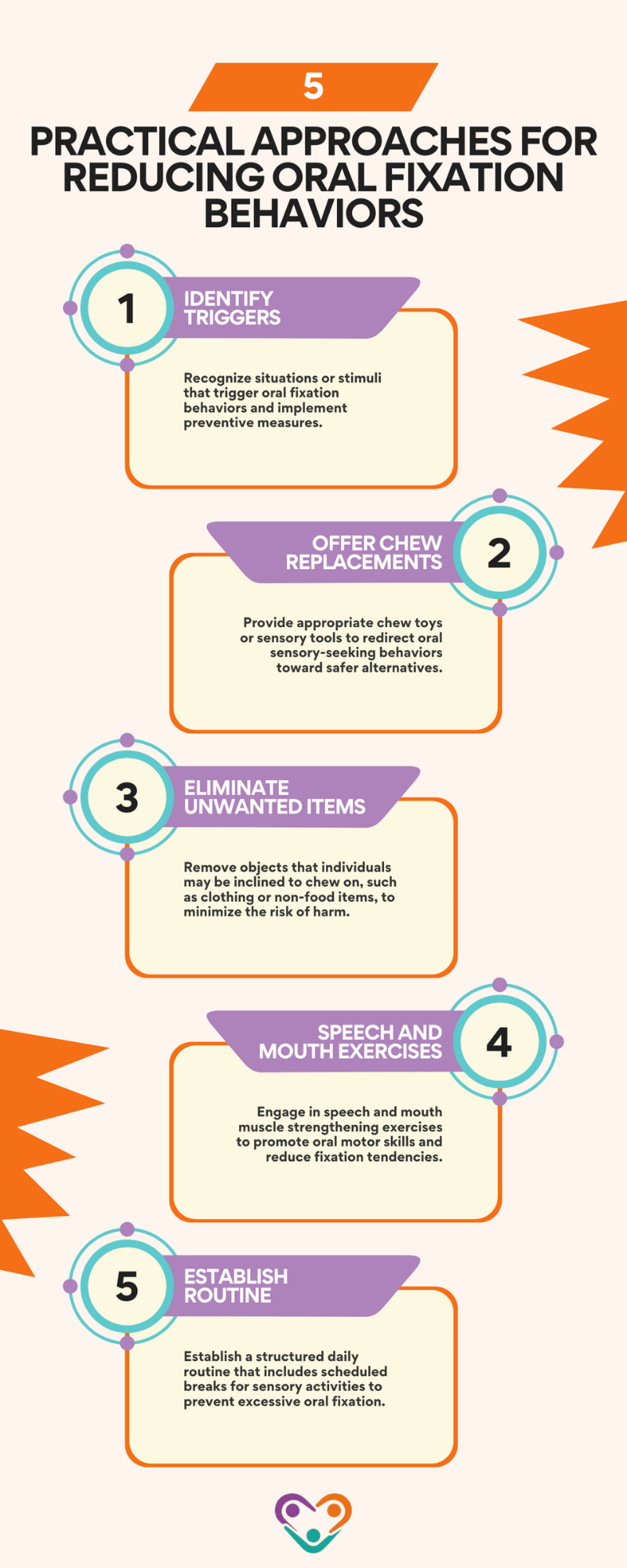Oral fixation is a natural part of many people’s lives, but for individuals with autism, it can take on a unique and sometimes intense form. This strong need to chew, lick, or mouth objects isn’t just a random habit – it often serves an important purpose.
Many individuals on the autism spectrum use oral activities to self-soothe, focus, or process overwhelming sensory input. By exploring the reasons behind these behaviors, we can better understand what oral fixation means in the context of autism, why it happens, and how it can be supported in safe, effective ways.
The Connection to Sensory Processing
Autistic individuals often grapple with sensory processing disorder, and this paves the way to oral fixation and heightened chewing tendencies. The DSM-5-TR designates sensory reactivity as a diagnostic criterion for autism, underscoring the prevalence of sensory challenges in individuals on the autism spectrum.
Sigmund Freud’s theories shed light on the roots of oral fixation in autism, associating this fixation with the oral stage of infancy development.
Freud posited that early or delayed weaning could catalyze the onset of oral fixation, with these behaviors often emerging as coping mechanisms in the face of stress or overwhelming situations.
Autistic children often grapple with sensory disparities, particularly oral sensory processing challenges that can significantly impede their eating habits, speech articulation, and communication efficacy. These differences underscore the complexities of navigating daily interactions and routines.
Moreover, some children with autism demonstrate a pronounced oral fixation, utilizing their mouths as instruments of exploration to navigate the world around them. This behavior serves as a coping mechanism for managing stress or anxiety, potentially driven by sensory processing discrepancies that render oral modalities less distressing than other sensory inputs.
Behavioral Manifestations
Understanding the behavioral manifestations associated with oral fixation in autism is crucial for caregivers and individuals dealing with this condition.
There are two common behaviors observed in individuals with autism that relate to oral fixation. Let’s look at each of them.
Pica Behavior
Research from a study revealed that pica behavior, characterized by the ingestion of non-edible items, affects approximately 23% of autistic children between the ages of 2 and 5.
This behavior poses a significant health risk, especially in preschool-aged children. Caregivers and parents need to be vigilant in monitoring and addressing pica behavior to prevent potential complications arising from ingesting non-nutritive substances.
Stimming and Nail-Biting
Nail biting is often categorized as a form of stimming and can serve as an indicator of oral fixation in individuals with autism. Stimming, short for self-stimulatory behavior, plays a vital role in regulating emotions and creating a sense of comfort for those with autism.
Engaging in stimming behaviors like nail biting prompts autistic individuals to seek sensory input to self-soothe and cope with their environment.
Recognizing the connection between stimming, nail biting, and oral fixation is essential for caregivers and individuals with autism. Addressing these behaviors through appropriate interventions and support can help manage oral fixation tendencies and promote overall well-being for individuals on the autism spectrum.

Impacts on Daily Living
Children with autism often experience sensory differences, including oral sensory processing issues that can significantly impair their ability to communicate effectively. Oral sensitivities and fixations can manifest in difficulty with articulation, enunciation, and speech clarity, posing obstacles to clear and coherent communication.
These challenges can hinder their social interactions, academic progress, and overall quality of life.
Oral sensitivities and fixations can also have detrimental effects on the dental health of individuals with autism. The constant mouthing of objects, licking behaviors, or thumb sucking can lead to malocclusion of teeth, deformation of the soft palate, and other dental issues.
Over time, these habits can cause misalignment of teeth, cavities, and oral hygiene concerns, necessitating comprehensive dental care and frequent monitoring.
Understanding the challenges faced by individuals with autism due to oral fixation is crucial for caregivers and families to provide appropriate support and interventions. By addressing communication barriers and promoting good dental hygiene practices, caregivers can improve the overall well-being and quality of life of individuals with autism.
Seeking guidance from healthcare professionals, including occupational therapists and speech therapists, can offer tailored strategies to mitigate these challenges and enhance daily living experiences for individuals with autism.
How to Manage Oral Fixation
In terms of addressing oral fixation in individuals with autism, a multi-faceted approach combining occupational therapy support and strategic intervention strategies can be highly beneficial in managing this challenging behavior.
Occupational therapy plays a crucial role in supporting individuals with autism who exhibit oral fixation behaviors. Occupational therapists can assess the underlying sensory processing issues contributing to oral fixation and develop targeted interventions to address these challenges.
By working with individuals to better understand their sensory needs and preferences, therapists can help devise strategies to reduce oral fixation and promote more adaptive behaviors.
Additionally, occupational therapists collaborate with other healthcare professionals, caregivers, and educators to create a holistic treatment plan tailored to the individual’s specific needs. Through structured therapy sessions and personalized interventions, individuals with autism can learn alternative coping mechanisms and develop skills to manage their oral fixation tendencies more effectively.
In addition to professional therapy support, implementing specific strategies at home and in daily routines can help reduce oral fixation behaviors in individuals with autism. Here are some practical approaches that caregivers can consider:

Combining occupational therapy support with practical strategies tailored to the individual’s needs and preferences allows caregivers to effectively manage oral fixation in individuals with autism.
Consistent and patient application of these interventions can help promote positive behavioral changes and improve the overall quality of life for individuals with autism who experience oral fixation challenges.
How to Support Individuals with Autism
Parents and caregivers of autistic individuals or sensory integration disorders play a crucial role in the overall well-being and development of their loved ones. Family members need to seek diagnosis and treatment from qualified medical professionals, which may include occupational or speech therapy, environmental adaptation, behavioral modification, and sometimes medications.
Consultation with an occupational therapist or speech pathologist is highly recommended to identify the root causes of oral sensory-seeking behaviors in individuals with autism and to receive guidance and support for managing oral fixation effectively.
Working closely with healthcare professionals helps families gain valuable insights and strategies to address oral fixation behaviors and promote positive outcomes for the individual. At Golden Care Therapy, our dedicated ABA therapists in New Jersey offer specialized support designed to meet each individual’s unique needs.
Don’t hesitate to contact us today, and discover the difference our compassionate and effective services can make in your loved one’s journey. We’re here to guide you every step of the way.



